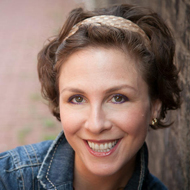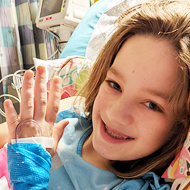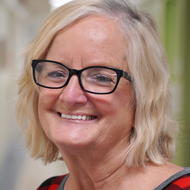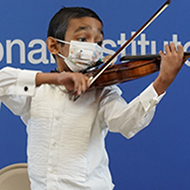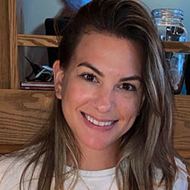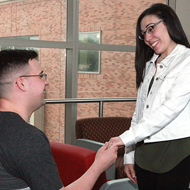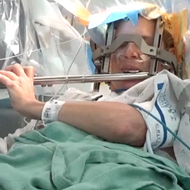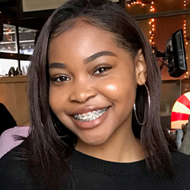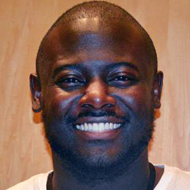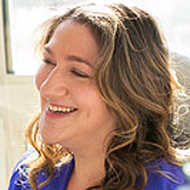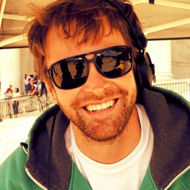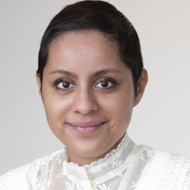Since we first opened our doors in 1953, more than 500,000 patients have participated in clinical trials at the NIH Clinical Center. These clinical research participants have been active partners with our staff in our mission to provide hope through pioneering clinical research to improve human health.
These are some of their stories.
Sarah (Myxopapillary Ependymoma)
Sarah was 37 years old when she was diagnosed with a myxopapillary ependymoma, a primary central nervous system (CNS) tumor.
Her search for the best treatment brought her to National Institute of Neurological Disorders and Stroke and treatment at the NIH Clinical Center. During her time at the NIH, she also enrolled in an National Cancer Institute natural history clinical study for central nervous system tumors.
Sarah shares three tips to enhance other patients' visit to the NIH.
Adeline Horne (Turner syndrome)
“She has always wanted to be a mother,” Andrew Horne says of his 10-year-old daughter Adeline, the oldest of his four children.
Welcoming her three younger siblings and watching them grow excited Adeline about the prospect of one day starting her own family. But shortly before Adeline’s seventh birthday, the family learned that she has Turner syndrome, a genetic condition that often causes infertility.
Adeline is participating in an Eunice Kennedy Shriver National Institute of Child Health and Human Development study evaluating a potential fertility preservation option.
Louise Benge (Undiagnosed Diseases Program)
Imagine visiting your doctor and having them tell you they have never seen symptoms like yours in their entire medical career.
The NIH Undiagnosed Diseases Program focuses on the most challenging medical cases referred to the Clinical Center. With the express goal of providing answers for patients with mysterious conditions and a general aim to learn more about these medical mysteries, UDP gathers teams of experts in many specialties from across NIH to work on these cases.
Louise Benge, has been enrolled in the program for a full decade, making a continuing series of visit to the Clinical Center for initial evaluation, ongoing study and follow-up.
Katie Coleman (Oncocytic Neoplasm)
Katie was first diagnosed with oncocytoma, a typically benign tumor, which makes up 15 to 20 percent of kidney tumors. What makes Katie’s case rare is that hers spread.
Due to the rarity of her tumor, it took some time for Katie to get her first diagnosis: an unclassified oncocytic neoplasm that looked exactly like an oncocytoma. Oncocytomas that spread are so rare that Katie’s is likely the only known case of this rare kidney cancer in the United States and one of only a handful throughout the world. Katie's search for treatment brought her to the NIH.
She shares her journey and encourages patients to be their own advocates.
Caesar Santos (Sickle Cell Disease)
Caesar almost lost his life to sickle cell disease and after suffering multiple strokes beginning at age four, had to relearn how to play the violin each time.
But he defines resilience, and received a bone marrow transplant from his sister in a clinical trial at the NIH Clinical Center in the Cellular and Molecular Therapeutics Laboratory led by Dr. John Tisdale of the National Heart, Lung, and Blood Institute.
Alexandra Ambrico (Healthy Volunteer)
Alexandra is a “healthy volunteer” participating in the NIH clinical trial ”Brain Dopamine Function in Human Obesity.” The objective of the trial is to better understand how brain function, particularly dopamine activity, relates to body weight and eating behavior.
Just a few of the activities participants experienced during the trial included magnetic resonance imaging and positron emission tomography scans to measure dopamine, eating a special diet five days before an inpatient visit; a five-day inpatient visit to the Clinical Center, and additional tests.
Alexandra answers a few questions about what it’s like to be part of the trial.
Tom Kaminski (Tetralogy of Fallot)
Tom recently returned "home" to the NIH Clinical Center in celebration of his successful open heart surgery at the hospital five decades ago.
Tom was born with a tint of blue skin and blue fingernails. Due to a congenital heart defect known as tetralogy of Fallot, it was difficult for blood to flow to his lungs and for his body to get the oxygen he needed. In 1969, his parents brought Tom, now 7 years old, to one of the only places at the time doing heart surgery – the NIH Clinical Center.
One of the notes in his medical record of the surgery stated, "effective correction of this child's cardio-malformation shows that he will derive good benefit." Five decades later, he and his family could not agree more.
Marissa Amuso (Haploidentical Cord Blood Stem Cell Transplant)
Marissa has been participating in clinical trials at the Clinical Center since 2000 and is currently participating in a trial for a haploidentical cord blood stem cell transplant.
"I have been coming here for years, and without this place, I would not still be here. NIH has become a second home to me, and my doctors and nurses feel like part of my family," she said.
This made her then-boyfriend's surprise marriage proposal as she was completing an appointment all the more meaningful.
Julianna Nickel (Focal Dystonia)
Julianna, a musician, has a condition, called Focal Dystonia, a rare condition that is task-specific; it only affects her when she plays the flute. It is a neurological condition that took a while for doctors to diagnose.
ultimately her search for a treatment lead her to the NIH Clinical Center and a clinical trial trying a new treatment – DBS, or deep brain stimulation.
DBS has been quite successful in patients with other neurological conditions such as Parkinson's and essential tremor, but, this was the first time surgery of this kind has been used to treat Focal Hand Dystonia in musicians.
Trina Davis (Skeletal Underbite)
Trina and her family are part of a natural history protocol led by Dr. Janice Lee, the clinical director at the National Institute of Dental and Craniofacial Research.
Patients with skeletal underbites (or severe overbites where there is underdevelopment of the lower jaw) deal with headaches, trouble breathing, speech impediments and problems eating and more. The five-hour operation to fix Trina's underbite, caused by underdevelopment of her upper jaw and overdevelopment of her lower jaw, was the first time the procedure was performed in the Clinical Center.
"I feel good that I'm able to contribute to research [and that this] research will help somebody else," said Trina.
Lynndrick Holmes (Sickle Cell Disease)
Lynndrick was diagnosed with sickle cell disease at birth but the disease took the greatest toll on him as an adult. He enrolled in a gene therapy trial at NIH with guarded hopes after exhausting many avenues of treatment. Initially guarded, his participation in the trial, he says, was “soul-awakening”
The clinical trial, which is still recruiting participants, is testing a novel gene replacement therapy in people with severe sickle cell disease.
He shares his experience being free of the sickle cell disease two years after receiving genetic treatment during a clinical trial at the NIH Clinical Center.
Harper spent the first 27 years of her life hiding her rare disease from family and friends before making the decision to seek help at the NIH.
Harper remembers feeling terrified riding in the car with her parents to Bethesda. Her fears were quickly allayed when she arrived at the Clinical Center. “Nobody has taken care of me like this team. They care on a personal level. ... They were so dedicated to figuring things out,” she said.
Her podcast Made Visible highlights the difficult and brave journeys of regular people who struggle daily with chronic illness but don’t let it rule their lives.
David Fogel (Hereditary Diffuse Gastric Cancer)
David was diagnosed with hereditary diffuse gastric cancer (HDGC) caused by a mutation in his CDH1 gene. Having HDGC does not always mean that a person actually has cancer. Unfortunately, in David's case, it meant the risk of getting diffuse gastric cancer increased to almost 80%.
David's search for options and answers led him to the NIH Foregut Team and Dr. Jeremy L. Davis, a principal investigator on gastric cancer clinical studies and a surgical oncologist at the National Cancer Institute. He enrolled in a clinical study at the NCI and had surgery at the NIH Clinical Center.
Llasmin Canseco (Chronic Granulomatous Disease)
At 6 months old, Llasmin Canseco was diagnosed with Chronic Granulomatous Disease, a rare inherited disorder that weakens the immune system. Her granulocytes fail to produce microbe-killing hydrogen peroxide, leaving her with chronic inflammation and defenseless against infections.
In 2016, she acquired a fungal pneumonia that progressed to infect and partially destroy her chest bones leaving her doctors scrambling to find a treatment before it turned deadly.
So, in March 2016, at age 26, she enrolled in an NIH clinical trial that would attempt to give her a brand new immune system and a second chance at life.
More personal stories are available on the NIH web sites NIH Clinical Research Trials and You and Voices of the NIH Community.
You can also watch the Discovery Channel's three-part documentary First in Human. Discovery spent more than a year embedded at the Clinical Center capturing the real-life experiences of our doctors, researchers, staff, patients and their caregivers.


